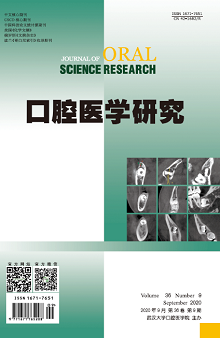|
|
Effects of Puerarin on Alveolar Bone Resorption and OPG/RANKL/RANK Pathway in Rats with Periodontitis Based on IL-23/Th17 Inflammatory Axis
ZHANG Li, LIU Yusong, WU Yunfei, FU Qiya
2020, 36(9):
844-849.
DOI: 10.13701/j.cnki.kqyxyj.2020.09.011
Objective: To investigate the effects of Puerarin on alveolar bone resorption and protein osteoprotegerin (OPG)/nuclear factor κB ligand (RANKL)/NF-κB receptor activating factor (RANK) pathway in rats with periodontitis through interleukin 23 (IL-23)/T helper cell 17 (Th17) inflammatory axis. Methods: The SD male periodontitis rats were set up and randomly divided into control group, model group, and puerarin group, with 20 in each group. After 14 days of Puerarin administration, the pathological changes of periodontal tissues and cementum enamal junction to alveolar crest (CEJ-AC) were observed; osteoclasts were counted by HE staining and tartrate resistant acid phosphatase (TRAP) staining, the proportion of Th17 cells in peripheral blood was detected by flow cytometry, the expressions of IL-23 and interleukin 17 (IL-17) in serum were detected by ELISA, and Western blot was used to detect the expressions of OPG, RANKL and RANK in periodontal tissues. Results: Compared with the control group, the CEJ-AC, osteoclast, Th17 cell ratios, serum IL-23, IL-17 levels, RANKL, RANK, and RANKL/OPG protein levels in the model group and puerarin group were significantly higher (P<0.05), while the level of OPG protein was significantly lower (P<0.05); compared with the model group, the CEJ-AC, osteoclast, Th17 cell ratios, serum IL-23, IL-17 levels, RANKL, RANK, and RANKL/OPG protein levels in puerarin group were significantly lower (P<0.05), while the level of OPG protein was significantly higher (P<0.05). Conclusion: Puerarin may up-regulate OPG expression, down-regulate RANKL and RANK protein expressions through IL-23/Th17 inflammatory axis, so as to control alveolar bone absorption, and promote alveolar bone repair and reconstruction in rats with periodontitis.
References |
Related Articles |
Metrics
|

